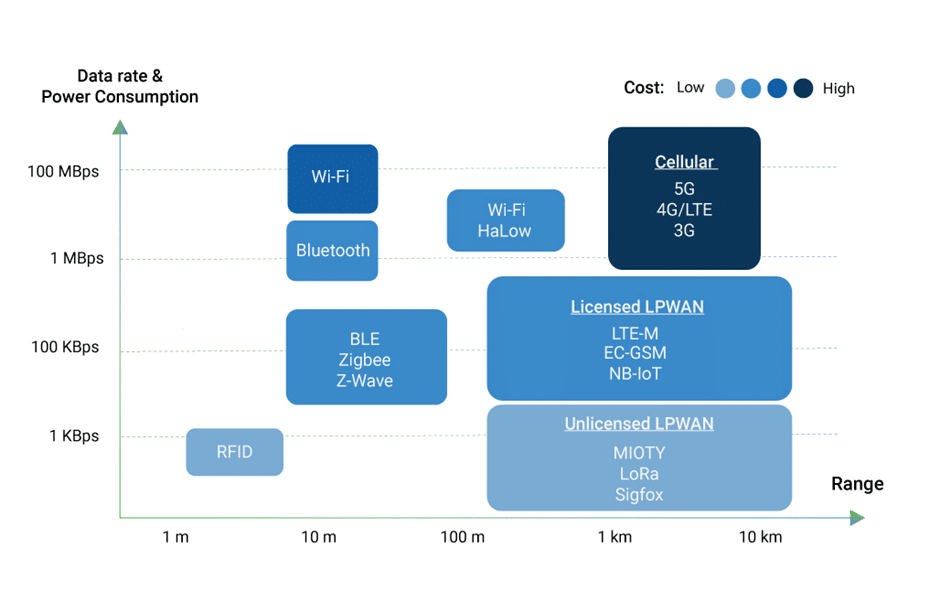Quick Summary
Business leaders need to understand that cellular IoT connectivity offers broad coverage, reliability, and scalability. It is crucial for deploying large-scale IoT networks and ensuring robust, long-term connectivity.
IoT is a gigantic network of connected “things” – unique hardware devices that transmit critical operational, transactional or sensor data. Anything can be connected from your toothbrush, a vending machine to wearable technology in healthcare. IoT can be applied to any industry and is enabling us to lead smarter lives.
For any IoT device to deliver on its promise, it must have access to a secure, reliable connection. Are you looking to produce and deploy IoT devices but not sure which connectivity solution you need?
After reading, you’ll know whether cellular connectivity is the best route for your IoT initiative and what to look for in your IoT connectivity provider.
How cellular IoT connectivity works
Cellular networks are based on open, global industry standards, use licensed spectrum, and are always operated by wireless network providers.
Cellular connectivity works for IoT by transmitting data packets over-the-air through wireless spectrum to mobile network operator’s cell towers. There are over 700 mobile networks in the world and thousands of cell towers.
Cellular connectivity allows information to be sent back and forth using mobile networks and includes services like 2G, 3G, 4G, 5G, LTE Cat. 0, LTE Cat M, NB-IoT, 4G LTE, LTE Advanced and 5G.
Learn more about the types of cellular network
Is cellular IoT right for you?
Cellular connectivity is utilised by IoT devices in all industries from smart cities, smart vending machines, telehealth, energy, point of sale and payment processing, to logistics and supply chains.
Here are advantages and disadvantages of cellular connectivity which will help you decide if it’s the right connectivity solution for your device:
| Technology | Frequency | Data Rate / Power Consumption | Range |
| Bluetooth | < 1 GHz | 1 MBps | Up to 50m |
| Wi-Fi | 100 MBps | Up to 50m | |
| BLE:- Zigbee- Z-Wave | 100 KBps | Up to 100m | |
| GSM (2G, 3G) | Cellular bands | 1 - 100 MBps | Up to 10km |
| LTE (4G) | Cellular bands | 100 MBps | Up to 10km |
| LTE (5G) | Cellular bands | Up to 1GBps | Up to 10km |
| Licensed cellular LPWAN- LTE-M- EC-GSM- NB-IoT | Up to 1 MBps | Over 10km | |
| Unlicensed LPWAN- MIOTY- LoRa- Sigfox | Up to 20 KBps | Over 10km |
But one size does not fit all when it comes to IoT connectivity. Here’s a visual overview of how each technology stacks up in terms of cost, data rate, power consumption and range.

Diagram from Industry Today: Best Uses of Wireless IoT Communication Technology
Which network should I choose?
Our technical consultants are often asked this question and their answer is always the same. It depends on what you are trying to do, the problem you want to fix, your use case and how quickly you need your data to arrive. Choosing the right IoT connectivity type involves careful consideration of factors such as range, power consumption, data transfer rates, and cost. We recommend a device-first approach to ensure your device connects everywhere, every time.
Read our tips for choosing the right connectivity option
Choosing the right SIM
The size and form of a physical SIM is known as its form factor (FF). Although the physical size differs, the capabilities of each form factor are the same. The choice of form factor depends on considerations such as the amount of space available for the SIM and the environment in which the devices will be used.
Multi-IMSI SIMs
Multi-IMSI SIMs are often used in IoT because they are capable of maintaining a high level of connectivity and therefore device uptime. They are able to offer a fallback solution because there are multiple IMSI profiles – and connection options – stored on a single SIM. This means that it can switch networks to respond to circumstances like network failures and roaming restrictions, and ensure the IoT device remains connected to the best available network.
Learn more about multi-IMSI SIMs
eSIM with eUICC network switching
With modern eSIMs, switching from one connectivity service provider no longer requires the physical SIM to be changed. eUICC empowers devices to independently interchange connectivity to achieve the highest levels of service and availability, the best rates for data, and uptime.
eSIM is conceived as a flexible, over-the-air solution enabling the SIM to use a local MNO network profile or a choose from a greater choice of roaming partners.
iSIM
The integrated SIM is relatively new technology which emerged in 2021. Less than 1mm² in size, the iSIM is integrated directly into the system processor as an integral part of the System-on-Chip (SoC).
iSIM is perfect for smaller devices because of the space saving benefits it offers. It also draws less power from the battery to operate which improves performance.
The security inherent with an iSIM means it can be used as a secure Root of Trust (RoT) to provide authentication and security for other applications. This reduces the overall attack surface of the device and makes it difficult for hackers to infiltrate.
How to maximize coverage and uptime
Transforma Insights report that “cellular networks today cover around 98% of populated areas. However, they’re a long way short of 98% territory coverage – often closer to 60%.”
For this reason, you can’t rely only on one network’s connectivity for global coverage and high-uptime. For IoT devices to work at optimum levels they must have access to a consistent, secure, and reliable connection always, regardless of location. To achieve this result, additional networks and infrastructure redundancy strategies should be in place for connecting devices.
Global connectivity with localised SIMs
IoT roaming is one of the solutions to enable connectivity in many countries around the world and when it works, roaming can be invaluable for IoT deployments, but if a device is connected to a roaming network continually, it is “permanently roaming“.
Permanent roaming is known for preventing the success of global IoT deployments. Cellular IoT connectivity providers have historically used roaming to increase their global connectivity levels, but recent permanent roaming restrictions imposed by country regulators or networks can lead to extortionate charges for data usage and removal of devices from the network.
Learn more about eSIM localisation
Network switching with SGP.31/32
The GSMA has developed a new remote SIM provisioning (RSP) standard for IoT. SGP.31/32 eliminates the need for complex integrations between providers and support constrained devices.
Once fully functional SGP.31/32 solutions are available, it will make it easier for providers to access profiles from partner MNOs. This functionality enables the device to switch to different networks to achieve optimum connectivity.
Enhanced network redundancy with Multi-RAT technology
Multi-RAT connectivity solutions give IoT devices total connectivity freedom to choose which network type they connect to.
IoT devices that support a combination of cellular, Wi-Fi, Bluetooth, Near Field Communication (NFC), satellite and other protocols are more resilient to changing connectivity environments. This multi-RAT capability enables the device to optimise connectivity and helps to future-proof the IoT initiative and estate.
Learn more about Multi-RAT IoT
Managing connectivity
A connectivity management platform (CMP) enables organisations to effectively manage connectivity across a global IoT deployment. It offers flexibility and choice – devices can switch connectivity to a network that suits them best, and the CMP allows continuous monitoring and management of devices at an individual and aggregated level.
But selecting the right IoT connectivity platform for your organisation or project can be baffling. How do you arrive at a solution that not only delivers the connectivity and functionality you require today, but which can evolve as the technology environment changes and the business grows?
We’ve used insights from a recent Kaleido Intelligence survey of 750 enterprises, to identify five core capabilities that should be on your ‘must-have’ list when researching and scoping out an IoT connectivity platform.
Learn more about connectivity management platforms
Securing your IoT devices
The majority of IoT devices are unmanaged and were not designed with security or management in mind, making them easy targets for malicious attacks which can be devastating for an organisation and its customers.
With this in mind, it’s crucial that organisations treat IoT security seriously. Organisations with IoT devices deployed around the world need to be able to mitigate risk to ensure operational resilience and business continuity by securing the environment, and extending policy, security, and compliance from the centre to the edge.
How Eseye can help
Our intelligent patented network switching AnyNet technology helps organisations achieve near 100% secure universally available cellular connectivity for their IoT devices.
We have established the AnyNet Federation and has 16 direct ‘interconnect’ partnerships with MNOs worldwide, which combine to deliver access to 700 operators’ networks.
These special partnerships enable our customers to seamlessly switch from one operator profile to another, meaning that coverage blackspots are eliminated. It also means devices can be localised onto local networks. No other IoT connectivity provider has access to this unique network of interconnects or can offer a similar device localisation capability.
Our AnyNet offering means organisations only need to design, deploy, and manage a single device SKU which works globally; reducing the time, cost, and complexity of an IoT development and deployment when compared with the standard, fixed-network approach.
Paul is one of Eseye’s co-founders. With a background in senior design engineering, Paul’s focus is on ensuring his development, operations and support teams deliver solutions that work faultlessly in the field.
Paul was co-founder of CompXs, with Ian Marsden, and developed the world’s first IEEE 802.15.4 radio. Before CompXs, Paul was in senior radio design at Philips.
In this article
- Is cellular IoT right for you?
- Which network should I choose?
- Choosing the right SIM
- Multi-IMSI SIMs
- eSIM with eUICC network switching
- iSIM
- How to maximize coverage and uptime
- Global connectivity with localised SIMs
- Network switching with SGP.31/32
- Enhanced network redundancy with Multi-RAT technology
- Managing connectivity
- Securing your IoT devices
- How Eseye can help
